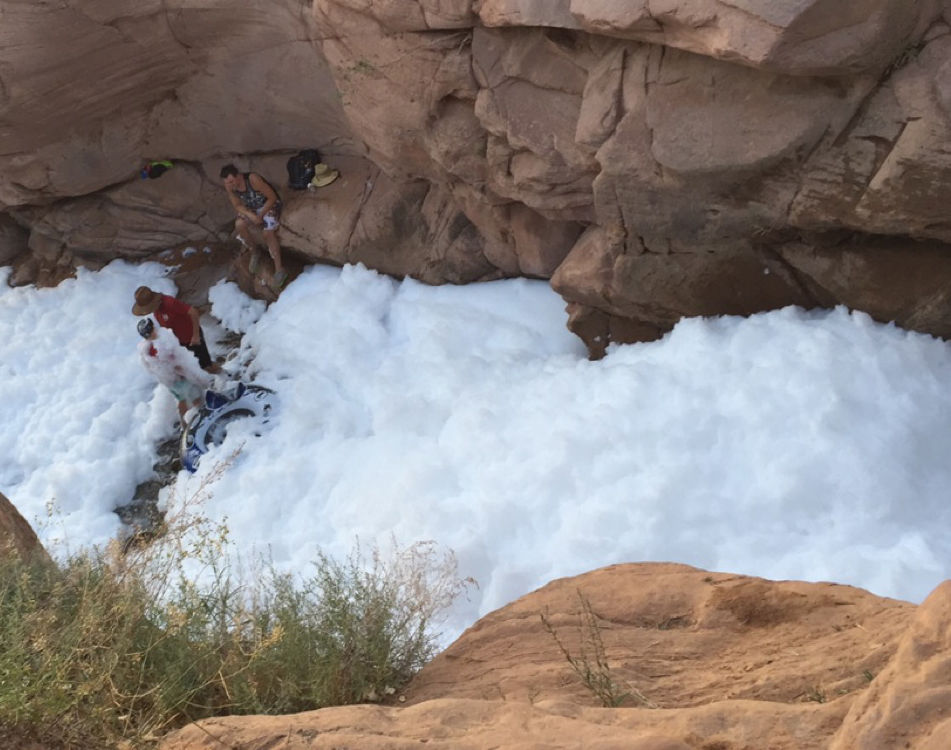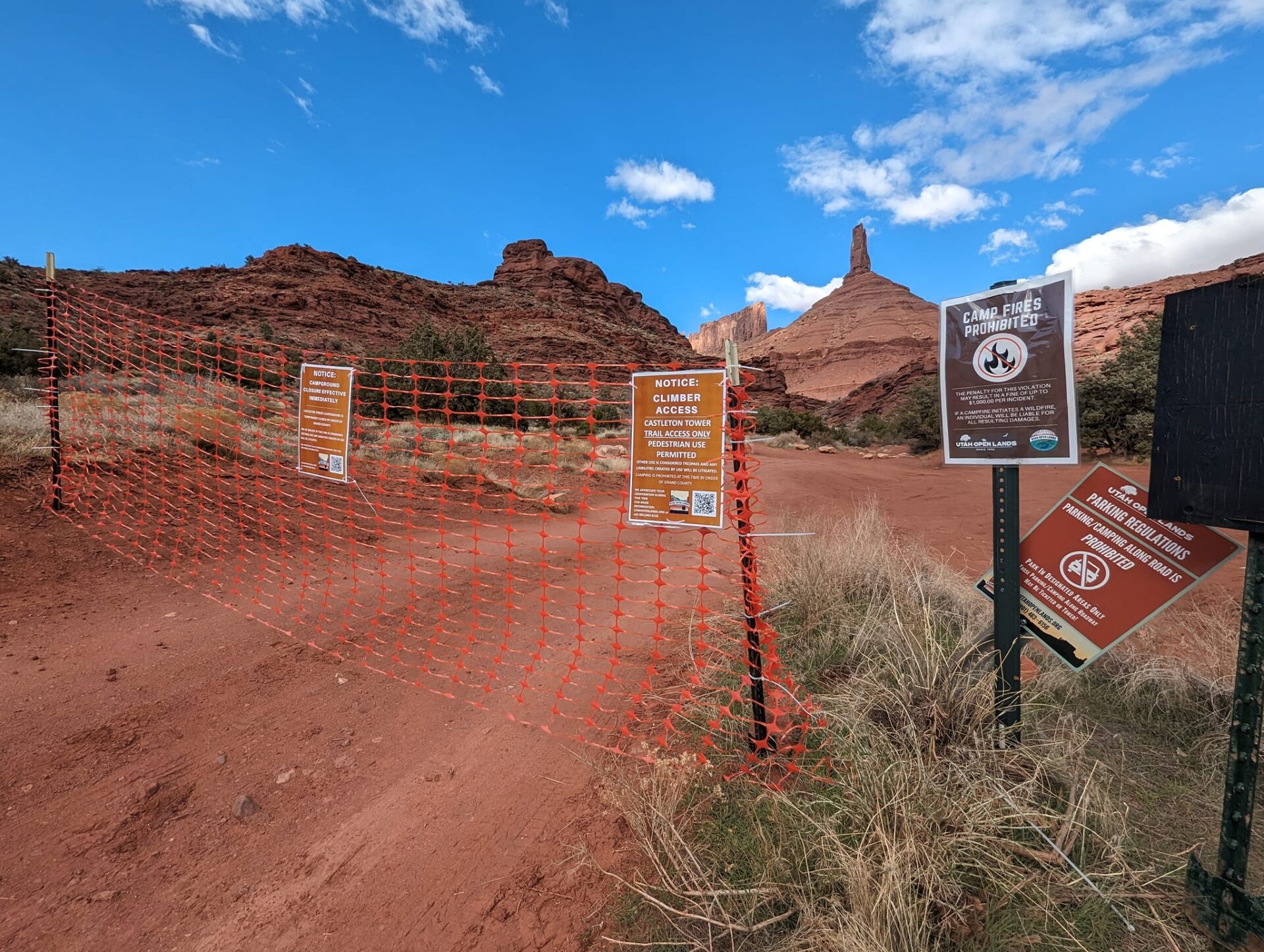Someone poured an unidentified foaming agent into Mill Creek last week, and while preliminary surveys found no immediate signs of harm to aquatic life, officials say the incident not only violates common sense, but numerous state and federal laws.
“It’s visually offensive, it’s unnatural to the ecosystem and it’s in violation of our water quality standards,” Utah Division of Water Quality Director Walt Baker said.
“This is somebody who didn’t think it through very carefully and didn’t make the proper choice,” U.S. Bureau of Land Management (BLM) Public Affairs Specialist Lisa Bryant said.
Sara Melnicoff of Mill Creek Partnership and other concerned citizens came forward last week to report the incident below the old dam site off Powerhouse Lane, which likely occurred some time between 6 and 8 p.m. on Wednesday, July 27.
A photo that has since been removed from social media sites shows two adults and three children frolicking in the foam. Authorities have not been able to identify any of the individuals, who reportedly told the photographer that they did not dump the foaming agent into the creek.
“They’re far away,” Bryant said. “It’s not possible to do.”
Investigators don’t have any solid leads on suspects yet, so the Grand County Sheriff’s Office is asking members of the public to come forward with tips that could help them in their investigation.
“They don’t have to state their names,” Grand County Sheriff’s Lt. Kim Neal said. “Any information is anonymous if they prefer to stay that way.”
With little information to go on at this point, officials are speculating that the foaming agent may have been a household detergent. Even so, Bryant and others pointed out that “biodegradable” soaps are harmful to fish, insects and invertebrates – including rare species that inhabit downstream areas near the creek’s confluence with the Colorado River.
Bryant said that surveyors took water samples from the creek and sent them off to a state lab for analysis. While the lab results aren’t back yet, Utah Division of Water Quality District Engineer Scott Hacking said a two-mile survey of downstream areas found no signs of impaired critters.
“Fish are still there (and) bugs are still there, so we don’t think there was any real, lasting damage,” Hacking said.
Southeastern Utah District Health Department Environmental Health Scientist Orion Rogers said that water was flowing down the creek at a minimum of 3 cubic feet per second, which could have flushed any contaminants out of the system.
“That’s a ton of water,” Rogers said. “It might be that dilution is helping us out.”
However, Bryant noted that surfactants in detergents can remain in the water long after the foam has dissipated, and they have the potential to be far more harmful to aquatic life.
Melnicoff said the sight of all that foam would appall any like-minded person.
“The people who care about these natural features would be horrified,” she said.
But she was not surprised to see that someone else degraded a designated Area of Critical Environmental Concern that is increasingly feeling the strains of more and more visitors.
Since the late 1990s, Mill Creek Partnership volunteers have been caring for the scenic canyon by removing trash and recyclable materials; naturalizing user-created trails; and controlling noxious and invasive weeds.
“I’ve pulled out hundreds of thousands of pounds of trash and recycling since 2004 (alone),” Melnicoff said.
Baker said his office is not aware of past foaming incidents near Moab – or anywhere else in the state, for that matter. However, Melnicoff believes there are those who will see photos of the foam and take them as a cue that it’s OK to dump something else in the creek – an act that she repeatedly takes pains to discourage.
“We don’t want someone putting something more toxic in there,” she said.
While it looks like Mill Creek’s aquatic species weren’t harmed in this case, both Bryant and Baker want to emphasize that the incident could have had a very different outcome.
“I don’t want people to get the impression that this was OK,” Bryant said.
“What we’re trying to do is send a message that this is not acceptable,” Baker said.
In addition to violating state water laws and the federal Clean Water Act, Bryant said the suspect – or suspects – broke numerous federal laws that prohibit the pollution or contamination of water sources, as well as the disposal of industrial or household wastes. The federal offenses alone carry potential penalties of six months in jail, and anyone who is convicted faces a possible fine of up to $1,000 per violation.
While the BLM hasn’t been able to identify any suspects yet, Bryant said her agency is heartened by the public’s concerns about the incident.
As soon as the emails and phone calls from citizens began to pour in, she said her agency took immediate action and coordinated with other entities. Responders included representatives from the Utah Department of Environmental Quality, the fire department’s hazardous materials crew and the Grand County Sheriff’s Office.
They had a plan in place by 8:30 a.m., and the first BLM responder was on site within half an hour.
“That kind of coordinated effort was possible because everyone was really good about contacting us and letting us know,” Bryant said.
By the time that someone alerted officials at the Division of Water Quality, Baker said the acute impacts to the creek were already behind them. Days later, Baker said he doesn’t expect to see signs of dead fish who ingested any foam, or residue from soap scum.
“To my knowledge, there are no long-lasting impacts,” he said.
Bryant said she hopes that the incident ultimately reminds people of Mill Creek’s value to Moab: It recharges the aquifer, is a source of irrigation water and benefits recreationists and wildlife alike.
“That creek is the lifeblood of this community, and it’s up to all of us to respect it and protect it,” Bryant said.
Rogers, likewise, thinks of water as the community’s livelihood.
“Why would you purposely pollute it?” he asked.
Officials seek public’s help in identifying suspects who contaminated beloved local stream
That creek is the lifeblood of this community, and it’s up to all of us to respect it and protect it.
If you have any information about the incident, please contact the Grand County Sheriff’s Office at 435-259-8115, or the BLM at 435-259-2100. If you would like to volunteer to help keep Mill Creek Canyon clean, contact Sara Melnicoff at 435-259-0910, or learn more at www.millcreekpartnership.net.




